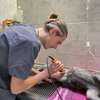Clinique Vétérinaire St-Hubert, veterinary surgery near Monaco
Our team is trained in several types of surgery
Our clinic is equipped with high-performance materials for all types of surgery. Dr. Conti is an experienced surgeon, who has trained throughout Europe and the United States. He is highly skilled in soft tissue and orthopedic surgery.
Our surgical suite is equipped with a Datex Ohmeda monitor with ECG control (heart rate, 7-channel ECG tracing, arrhythmia analysis), end-tidal capnometry, inspired fraction, CO2 tracing, respiratory rate, respiratory tracing, oxygen saturation, pulse rate, SpO2 pletysmogram, systolic, dyastolic and mean pressures, body temperature with esophageal or rectal probe, gas anesthesia with isoflurane evaporator with various circuits, automatic respirator, oxygen concentrator, surgical lamps, Mistral air patient warmer, Combibag resuscitator.
For orthopedics, we are equipped with Syntex and other equipment for nail and plate insertion, bone grafting, PRP, TTA, TPLO.

Booking an appointment for our surgery department
We advise all our customers to make an appointment for a pre-operative visit, during which they can ask any questions they may have; the animal is examined, and additional tests such as blood tests, X-rays, ultrasound and cytology can be suggested.
How does the procedure work?

The day of surgery
The animal is welcomed by our ASVs, who weigh it, have the owners sign the consent form and answer any questions the owner may have. The patient is then prepared for anesthesia. A veterinarian takes care of auscultation, intravenous catheterization, blood tests if not yet performed, and shaving the animal at the surgical site. The patient is then preanesthetized; preanesthesia allows the animal to relax, and is generally composed of a mixture of drugs that remove nociception and pain. The little doggie is then placed in a cage with heating for the time needed for the preanesthetic to take effect; during this time, the veterinary surgeon and his assistant prepare the surgical room; the equipment has already been sterilized. Once relaxed, the anesthetic is applied intravenously with propofol or alfaxolone, and a tracheal tube is inserted to ventilate the animal, provide oxygen and supply volatile anesthetic (isoflurane) for the duration of the surgery. The animal is washed with a chlorexidine shampoo; then the patient is transferred to surgery; he is placed on the surgical table on the heating mat, and connected to the monitor and vaporizer. This is when the surgeon arrives; after scrubbing his hands, he is dressed sterilely.
For the duration of the surgery
The animal is assisted by the anesthetist. Once finished, the anaesthetist performs pain therapy, and the veterinary surgeon takes care of any bandaging. The animal is then transferred to the recovery room in a heated cage, still monitored, and the perfusion is maintained until it is time to go home. Whenever possible, animals are sent home on the evening of surgery, as we believe they will feel better than in a cage.
If necessary, they will remain hospitalized under supervision.
Post-operation checks
Dr. Robotti often takes on small patients who need to be monitored, or whose owners are afraid they won't be able to manage the post-operative period.
At the time of departure, a prescription is given to the owners with the necessary medication (antibiotics, anti-inflammatories, painkillers, etc.) as well as instructions for feeding, walks, physiotherapy, etc.
Dr Robotti is available for questions at any time after surgery.